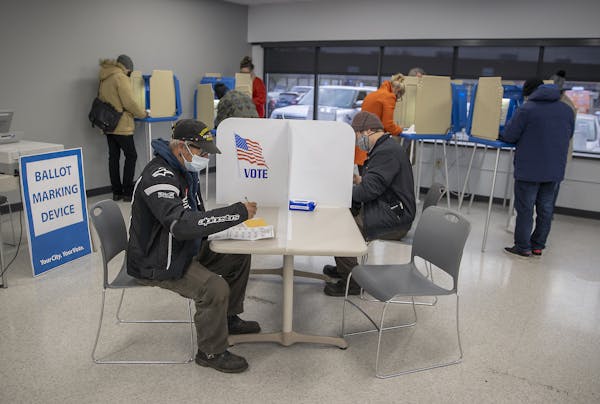Nearly 1.2 million Minnesotans have cast an early ballot, crushing past records with more than a week to go until the Nov. 3 election.
The latest early vote figures, released Friday by the Secretary of State, mark an unprecedented increase over 2016. The volume of early ballots accepted this year is already almost double the number counted for the entire 2016 election, when about 676,000 Minnesotans voted before Election Day.
With 11 days left to vote, those numbers are expected to rise. More than 1.7 million residents have requested absentee ballots so far, meaning hundreds of thousands more mail-in votes could be returned in the coming weeks. State law also allows voters to cast a ballot early in person.
Early voting has grown in popularity since Minnesota's no-excuse absentee law took effect for the 2014 election. But this year's surge in early voting reflects national trends, as more voters opt to cast a ballot ahead of Election Day in light of the coronavirus pandemic. More than 50 million Americans have voted early so far, according to the Washington Post. Requests for ballots are up in most states over 2016.
So far, Minnesota voters are both seeking absentee ballots at higher rates and turning them in earlier than previous years. Two-thirds of requested ballots have been submitted and accepted, surpassing the return rate for the Aug. 11 primary.
Pandemic concerns, including social distancing at the polls, is a driving force for some early voters. Janet Dennett, 74, cast an early vote Wednesday to avoid standing out in the cold on Election Day. She said she wanted to keep up a 56-year streak of participating in democracy.
"Nobody wants to go back; we're all trying to move forward for the best of everybody," she said
While it remains to be seen whether the early voting will translate into record turnout, about 30% of the state's eligible voters have participated so far. In 2016, 2.9 million Minnesotans, roughly 74% of those eligible, cast a ballot in the presidential election. One in 10 registered on Election Day.
National data suggest the trend could give an edge to Democrats, based on analyses in states that provide ballot breakdowns based on partisan voter registration.
Because Minnesotans do not register with a political party, that data isn't available here. But Hennepin County leads the state in raw early turnout, with 349,475 ballots accepted so far.
That turnout, already 73% higher than the county's 2016 early vote total, could be good for Democrats given Minneapolis' political leanings. But some rural areas that tend to vote Republican are also seeing big spikes.
Lac qui Parle, a western Minnesota county that President Donald Trump carried with 60% of the vote in 2016, reports a nearly 80% increase in accepted absentee ballots compared to the last presidential election.
Reports of Postal Service delays and comments from Trump questioning the integrity of mail-in voting raised anxiety about the process. Some voters interviewed by the Star Tribune have said such concerns prompted them to get their ballots in earlier than usual.
But Secretary of State Steve Simon said there have been few reports of voting problems in Minnesota so far.
"Generally speaking I'm really happy about where we are," he said. "There are always potential glitches but so far the process has run quite smoothly."
Some voters have reached out about the status of their ballot, but Simon said most "seem generally satisfied with the speed of their mail." The office's absentee ballot tracking site, mnvotes.org/track, has seen an uptick in interest.
Some voters have also questioned why their ballot came with a registration form when they haven't changed their address. The answer, Simon said, is often related to a name change or a system issue triggered by a hyphenated name. In such cases, the voter should fill out the form, ensuring that it matches the information on the ballot, and return it in the same envelope.
Legal challenges prompted a number of updates to the process this year. A witness signature requirement for mail-in ballots has been waived, except for voters who are also registering by mail. Another change allows ballots postmarked by Nov. 3 to count as long as they arrive within seven days of the election.
That extended window for processing ballots could delay calls in some close races this year. But because Minnesota allows local officials to begin processing received ballots and putting them in the counting machine within 14 days of the election, officials are not expecting as big a backlog as other states might face in releasing results.
Election officials recommend that Minnesotans planning to vote by mail send their ballot as soon as they have made their decision.
Staff writer Zoë Jackson contributed to this report.
Torey Van Oot torey.vanoot@startribune.com
Jeff Hargarten jeff.hargarten@startribune.com

Want to share info with the Star Tribune? How to do it securely

'Safe recovery sites' would offer syringes, naloxone and more to people using drugs. The plan could be in peril.
New Minnesota GOP leaders seek peace with party's anti-establishment wing

Who is Republican Lisa Demuth, Minnesota's first House speaker of color?

